BUSINESS
State of the Restomod Market
Transforming Old Classics Into Modern-Day Machines
The newest Icon Reformer presents a completely reimagined ’70 Ford Ranger and is powered by a 426hp Ford 5.0L Coyote V8 engine paired to a Ford automatic transmission. |
Undeterred by a sluggish economy brought on by COVID-19, demand for classic-car restoration is still soaring, and it’s likely to continue as long as parts suppliers can keep up. The clients are typically “car people” and are faithful to a particular make and model. While there are still those who insist on accurate restoration of classic cars, growth is to be found in those who want to retain the classic-car look but are thirsty for modern performance upgrades that improve drivability and promote individualism.
We spoke with three leading companies in the restomod segment to find out who their clients are, how they built their reputations, what the latest industry trends are and how they source their parts and establish partnerships. Here’s what they had to say.
Weathering the Storm
There’s still a lot of interest in one-off custom classics right now, but ensuring that customers have enough funds is another thing, according to Mike Ring of Ringbrothers. The Rings thought business would slow down due to COVID-19, but it’s actually been the opposite because people are getting anxious and just want to buy.
Jonathan Ward, CEO and lead designer for Icon, echoed that sentiment.
“We actually find that demand is far greater than our capability to provide it, meaning we try and focus most of our efforts on our production models, like the Bronco and FJ Series,” Ward said. “We purposely limit the scale of projects we do in this one-off series of vehicles to either the Derelict or Reformer style and only deliver maybe three or four of those a year.”
Despite COVID-19, the shop has stayed open, and clients are keeping up with their commitments. However, Ward has some concerns about Icon’s smaller sublet partners and whether they are going to be able to help them keep up with demand.
David Miller II, vice president of marketing for R3 Performance Products—a producer of body shells—shares Ward’s concern regarding the ability to continue purchasing parts from his suppliers, some of whom might not have fared so well in recent months.
“We’ve been able to get parts so far, but if everybody else shuts down, can we still get fenders and engines?” he asked. “We’re finally starting to see the ripple where we’re getting a little bit longer lead times on parts, but people are beginning to open back up, so hopefully that won’t last long.”
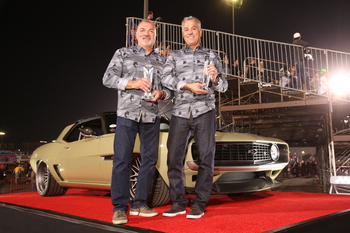 Mike (right) and Jim Ring held their trophies after capturing top honors at the 2019 SEMA Battle of the Builders. Their reimagined ’69 Camaro was judged best in show by their fellow finalists at the 2019 SEMA Show. |
Survival of the Fittest
Many shops want to do one-off custom restorations, but when it comes down to it, most don’t realize that it takes a large team and even more industry partners to pull it off and then be able to feel comfortable with the finished product, according to Ringbrothers.
“What really kills you in these jobs is that there’s no money left to warranty them when they’re done,” said Mike Ring. “It all comes out of your own pocket.”
There have always been shops that do custom one-off restorations, but interest in the vintage aesthetic has significantly increased, based on Ward’s experience.
“People don’t necessarily want to be a martyr to a vintage vehicle,” he said. “They have a strong affinity to the classic design style and continuity but no patience for the archaic mechanical experience. So probably the most notable segment of growth I’ve seen is to a more thoroughly reengineered and restored vehicle.”
On the other hand, Miller believes that there are 30% fewer shops doing custom restoration since the year 2000, largely because the paint and body shop world is consolidating. Most restoration is done in the back of a collision shop, and they do collision work because it’s steady and pays the bills.
“When collision slows down, the next thing you know they’re building a GTO out in the back,” Miller said. “Collision techs and restoration techs are two very different skill sets, but there are some shops that do great work.”
However, Miller lamented that when those types of shops get busy, they throw a tarp on the project and it collects dust. “That’s where you hear horror stories where a guy takes his car in and a one-year restoration project turns into four years. It’s bad for business, and it’s the reason why R3 no longer does collision,” according to Miller.
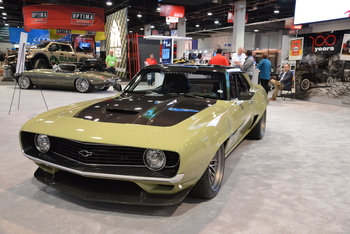 Ringbrothers unveiled a ’69 Chevrolet Camaro known as “Valkyrja” at the 2019 SEMA Show in Las Vegas. The 890hp musclecar was developed using the latest technology, including 3-D scanning and CAD design, and was assembled with modern materials, such as carbon fiber. Custom parts were created using a combination of 3-D printing and CNC machining. |
The Car-Faithful Resto Client
Icon generally builds one-offs for clients who have already gone down that road and have no interest in a conventional luxury vehicle. For instance, instead of building a Raptor with aftermarket accessories or a Rolls-Royce or a Ferrari, they’re looking for something that’s a bit more under the radar and a lot more individual.
“For the most part, our clients are self-made people who’ve gotten to where they are financially in their own career path by being sort of hands-on,” Ward said. “I think they respect and understand what we do on a much deeper level. The one-offs that we have built run anywhere from $200,000 to upwards of $1 million, so they range greatly in their design, priorities, style and era to pretty much run
the gamut.”
According to Miller, his restomod clients are typically older men with some extra money to spend. They’re car-faithful and knowledgeable about their vehicles. More often than not, the build clients aren’t car people; they’re wealthy and the project is their latest toy.
“The restomod customers who are Camaro or Mustang aficionados usually have some idea of what they want, and they’ll do their research on the Internet,” he said. “They’ll tell us that they’re thinking of getting a certain kind of brakes and will ask us what we think and if it will work, so they still need some help.”
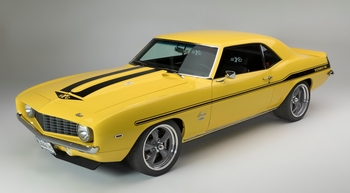 This officially licensed ’69 Yenko Camaro 427 S/C Continuation Car was built from start to finish on the Velocity Channel in fall 2018. It was the first new Yenko built in more than 40 years. |
Building a Reputation
Hailing from the small town of Spring Green, Wisconsin, the Ringbrothers brand is known throughout the world, but it’s fair to say the company built its reputation at the SEMA Show. Winner of the 2019 SEMA Battle of the Builders competition, Ringbrothers’ intent is to debut everything it’s worked on at the SEMA Show because the brothers feel that the exposure is much greater than any normal car show could ever give them.
“[The SEMA Show] is like the Super Bowl for us because of the media presence,” said Mike Ring. “When you’re in Los Angeles, there’s media everywhere, and you can shoot TV shows, but out here, clients have to take multiple flights, and it takes all day to get here. That’s why SEMA is so important for us. We throw everything we have at the SEMA Show.”
When you’re just starting out, it’s difficult to establish yourself as a standalone resto-only or build-only shop and convince potential clients to trust you, according to Miller. You can’t just rent a facility, spend money on equipment, hire technicians, and then expect clients to walk in the door.
“You have to draw clients from all over unless you’re in Los Angeles or New York,” Miller said. “So the question is, how did they find you? How do you develop a reputation? Even if they do find you online, how do you stack up to the other 10 guys doing it? I’ve been banging my head against that wall for decades, and business is just
now steady.”
Miller believes that his involvement in television shows representing one of his brands (Brand New Muscle Car) on Velocity and Motor Trend Network provides some evidence that he’s legit. R3 also exhibits at the SEMA Show, and Miller estimates that 30% of his business comes from repeat clients.
“I’ve done as many as 11 restos for one person,” Miller said. “Once you treat them right, they come back, because most of them have been burned before. We don’t even ask for a deposit. Give us the car, tell us what you want done, and we’ll just take it week by week, pay as you go.”
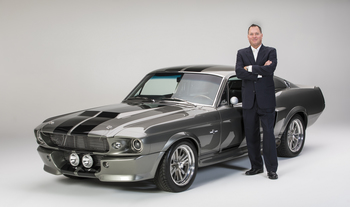 David Miller II stands in front of the officially licensed Gone in 60 Seconds Eleanor built by Brand New Muscle Car. This particular car features a brand-new R3 Performance Products Ford-licensed replacement body, R3PP front and rear suspension, a 5.0 Coyote engine, and a 6R80 automatic transmission. |
Prominent Restomod Candidates
The types of vehicles that are getting the resto treatment range from classic American muscle to four-wheel-drive trucks, particularly K5 Blazers, and Ringbrothers plans to bring an iteration of a K5 to the 2020 SEMA Show.
“We built a ’72 for ourselves and sold it for $305,000 on [digital auction platform] Bring a Trailer, but we don’t typically roll the dice like that,” said Jim Ring. “We always have a client we build for, and we don’t like to repeat something we’ve done already or even be similar. We like to change it up.”
Icon’s projects range anywhere from model years ’32–’75. Many people have personal relationships or attractions to particular vintage vehicles from their own life experiences or favorite movies, according to Ward.
“We like to do ’70s and older, where the quality foundation for the vehicles are such that they warrant the scale of work and reengineering that we like versus later-model vehicles where there’s really not much to work with,” Ward said. “Our interest starts to wane past that when you get into eras where the simplicity, quality and continuity of the design is arguably lacking, at least from our perspective.”
According to Miller, Mustangs represent about two-thirds of his business because it was the first pony car and also people are influenced by the Shelbys and Eleanors that are widely represented in movies and popular culture.
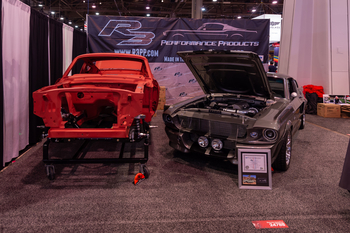 R3 Performance Products, located in Tulsa, Oklahoma, produces body and chassis solutions for ’65–’70 convertible and fastback Mustangs. |
Getting to the Source
The relationships Ringbrothers forges at the SEMA Show help the company to decide whom to work with. They tend to be companies that have been around and will continue to be around and have serviced or warrantied parts that went wrong.
“Over the years, you figure out what works and what doesn’t, and you stick with the ones that work and use those products and brands in your builds,” Jim Ring said.
There are many companies that sell parts, but it’s important to find one that knows how its parts work.
“It seems funny, but there are parts out there that are made by people who don’t have a clue about how their parts work,” Mike Ring said. “We understand our products. People who steal our parts, they have no idea. They just reengineer it, but they really don’t know how to answer questions. For us, that’s what it’s about—having people who will be there to help us out when we have issues, because everybody is going to have them.”
According to Ward, shops often take the approach that they can work on anything and everything, whereas Icon keeps an open mind about what platforms they work on.
“We are decidedly opinionated about how we do what we do, so we clearly define our build styles and the fundamental priorities that are basically revisiting classic transportation in a modern context,” Ward said. “If somebody were to come to us and say, ‘I want a ’57 Chevy just like it came off the showroom floor,’ we would tell him there’s probably a specialist out there better suited. We’re all about evolving the mechanical and electrical engineering to provide the most contemporary driving experience possible married to the traditional aesthetic.”
For Icon, the decision to become involved in a project is based on how excited Ward and his team are to do it. Ideally, it’s something that hasn’t been overdone. It’s also about the relationship with the pending client.
“We’ve been fortunate over the years as our reputation has become more firmly established to create some key relationships with top suppliers,” Ward said. “When it comes to sourcing aftermarket restoration parts, we’ll generally go to the best reputed licensee of those traditional parts. But we increasingly are designing and manufacturing our own solutions, because in general, the business models for those components have to lean more toward a one-size-fits-
all approach.”
| References | |
| Icon 9601 Lurline Ave. Chatsworth, CA 91311 818-280-3333 www.icon4x4.com Ringbrothers E4829 U.S. Highway 14 Spring Green, WI 53588 608-588-7399 www.ringbrothers.com R3 Performance Products 502 N. Redbud Ave. Broken Arrow, OK 74012 918-957-5090 www.r3pp.com |
What’s Trending
People want something unique, so they’re looking for different textures and colors—anything to stand out, according to Jim Ring. They want cars that look and feel different, but unless you actually manufacture the parts yourself, most people buy from the same hot-rod parts retailers.
“There’s no disrespect in that, but if everybody buys parts from the same company and nobody is creative in actually manufacturing different stuff, then everything looks the same,” Jim Ring said.
Ward is seeing more interest in electric powertrains. Icon has also released new editions of its old-school production vehicles in response to the clients’ desire to fly under the radar.
“Less social baggage, less obvious mods and more subtlety,” Ward said. “At first glance, you can’t even tell that something has been altered unless you intimately know that platform.”
Trends that Miller sees include clients who bring in an original car and want it blown apart and restored with all-new parts.
“It used to be the coolest, most unusual unique thing ever,” Miller said. “Now it’s the majority, where everybody who comes in has a list of the work they want done. There are fewer straight restorations. It’s been happening for a while, but it’s really peaking now where it’s actually become normal, and the clients don’t think they’re ruining their cars’ value. They pick and choose what they want like an à la carte menu.”
However, when a resto customer comes in with a stock car and wants to just do a straight restoration, that’s now special where it used to be the norm, according to Miller. He has also found that, in some cases, as more clients rebuild their classic cars with modern components, restomods have a higher value at auction than their original counterparts.
Like Ward, Miller is also seeing a prevalence of electric cars and people who make electric classics, including ’67 Mustangs and ’69 Camaros.
“Electric classics are just now starting,” Miller said. “Some guys are freaking out, thinking it’s the end of the world, but if it looks cool and it goes fast, I’m okay with it. Gasoline cars aren’t going away. Even if every soccer mom in the world is driving an electric minivan, somebody will still have an old gas-powered Mustang. They’ll be toys; they won’t be daily drivers. But they’re not going away—not in my lifetime.”






